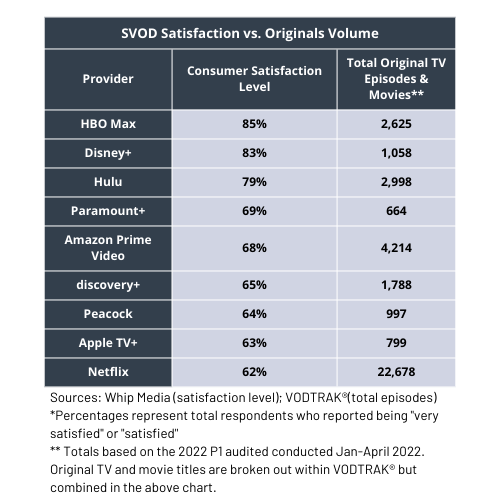Sometimes it’s fun to mash together data from different sources just to see whether any correlations exist. And while we acknowledge the ancient wisdom that one shouldn’t assume causation when comparing said values, Whip Media’s “Streaming Satisfaction Report” released this week gave us a little bit of pause. Over the last several years, Netflix, Amazon, and other SVODs have largely tried to prove their value (and justify steadily rising subscription fees) with volume. The mantra was about choice.

So many original shows and movies at your fingertips and on your schedule – for just a few bucks a month. Netflix has been the biggest promoter of this logic, with executives occasionally hinting that even if subscribers only care about one percent of its original content, that’s fine. Other baskets of subs love a different one percent. Everybody’s got a different handful of shows that keep them paying every month. And everybody’s therefore happy. Even comparatively tiny services with far fewer originals – but huge fandom around them – can play on this logic, with AMC Networks interim CEO Matt Blank famously declaring during a Q4 2021 earnings call that AMC+ is “not trying to be something for everyone. We are instead trying to be everything to someone.” So whether a person is a fair-weather fan of Netflix’s “Stranger Things,” “Squid Game,” “Ozark,” and “Money Heist” (but in concert, willing to pay the freight for access to all four), or that person is a superfan of just one show like AMC+’s “The Walking Dead,” the same basic logic applies. And in each case, you could argue that the subscriber is satisfied to pay a certain fee for certain shows.
High-volume SVODs that have spent billions creating original shows are playing a numbers game. If you want to keep millions of subscribers happy, throw everything at the wall and see what sticks just enough to keep them coming back for more every month. And if we look at the chart to the right, which compares the Whip Media data to our latest VODTRAK® intelligence service audit tallying total original TV and movie episodes per provider, it’s clear that sheer volume of original content often has little to do with individual satisfaction. Otherwise, Netflix’s 22,678 original titles would put it at least in the top 50 percentile if not number one. Instead, Netflix finds itself dead last. But However, Apple TV+, with one of the smallest slates of original episodes in the SVOD game, is also near the bottom even though “Ted Lasso,” “Severance,” and its original movie “Coda” have recently garnered massive buzz and awards. Plus, Apple TV+ is a quarter the cost of Netflix.
Next? Perhaps quality IP, not necessarily volume, could win the race in the end. After all, HBO Max, Disney+, and Hulu scored much higher in satisfaction than their peers, suggesting that Warner Bros. Discovery and Disney’s powerful and well-known franchises are the gift that keeps giving subscribers more reasons to keep paying. The volume game also has its nuances: Netflix, for example, actually needs more content than most of its peers because it insists on releasing entire seasons at once to facilitate its subscribers’ famous desire to binge, binge, binge. That’s Netflix’s choice, but you have to wonder if the SVOD – now under Wall Street pressure and about to reject years of corporate bias against commercial interruptions by launching an ad-supported tier in Q4 – will also temper its reluctance to release weekly episodes as HBO Max, Hulu, Disney+, Paramount+, and in fact just about all its competitors have done. Interestingly, Netflix declined to release the entire Season 4 of global hit “Stranger Things” on May 27 when it launched what it called “Season 4: Volume 1,” amounting to seven episodes. Just today (July 1), Netflix finally released Volume 2, which for some reason consists of just two episodes that are apparently longer than normal. So essentially, Netflix let fans binge 7 of 9 episodes all at once, made them wait a month, and is now releasing the season’s final two. It’s a cheat of sorts, but don’t be surprised if Netflix adopts this tactic for its biggest franchises (“Squid Game,” anyone?). After all, if one subscriber loves four shows and subscribes only for them, releasing them one at a time or in batches and timing new seasons appropriately over many months may help reduce seasonal churn while also sparking more excitement among fans. Those watercooler moments of “what will happen next” on social media only really work when people must wait a week for new episodes. Sometimes getting everything you want, all at once, isn’t nearly as fun as the anticipation stoked by being forced to wait. Anticipation may be the best aphrodisiac in a stream-obsessed world.
